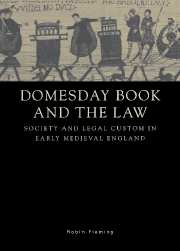Book contents
- Frontmatter
- Contents
- List of figures and tables
- Acknowledgments
- List of abbreviations
- Two brief notes on the texts and indexes
- Table of F numbers by county
- Frequency of legal information across counties and circuits
- Introduction
- Part I Domesday Book and the law
- Chapter 1 The inquest and the mechanics of justice
- Chapter 2 Living in the shadow of the law
- Chapter 3 Disputes and the Edwardian past
- Chapter 4 Disputes and the Norman present
- Part II The texts
- Part III Indexes
Chapter 3 - Disputes and the Edwardian past
Published online by Cambridge University Press: 14 January 2010
- Frontmatter
- Contents
- List of figures and tables
- Acknowledgments
- List of abbreviations
- Two brief notes on the texts and indexes
- Table of F numbers by county
- Frequency of legal information across counties and circuits
- Introduction
- Part I Domesday Book and the law
- Chapter 1 The inquest and the mechanics of justice
- Chapter 2 Living in the shadow of the law
- Chapter 3 Disputes and the Edwardian past
- Chapter 4 Disputes and the Norman present
- Part II The texts
- Part III Indexes
Summary
Remembering the past in 1086
By 1086 there were countless reasons for title to be questioned or claims against holders to be raised. First among these were the long-standing arrangements attached to new acquisitions, some of which were painfully complicated. Take, for example, Domesday's description of Leighs in Essex:
In the time of King Edward, Esger [the Staller] held two and a half hides and fifteen acres of land in Leighs. Now W. holds it from Geoffrey de Mandeville [Esger's successor]. Esger gave this manor to [Earl] Harold, and Harold then gave it to Skalpi, his housecarl. Skalpi then gave it to his wife in dower, in the sight of two men – Roger the Marshal and an Englishman. The hundred testifies that they heard these men acknowledge Skalpi. Skalpi himself held it after King William came into this land, until he went to York, where he died in outlawry.
After the Conquest, the men who had gained rights to Earl Harold's and Skalpi's possessions could challenge Geoffrey de Mandeville's title to Leighs, and so, too, perhaps could Skalpi's widow or surviving heirs. At other times it was impossible, twenty years on, to trace unambiguous title back through the confusing entitlements of English leaseholders, lords, and litigants. This was certainly the case with the Bishop of Worcester's estate of Alveston:
In the time of King Edward, Beorhtwine held seven and a half hides there. Archbishop Ealdraed had the sake and soke, and toll and team, and churchscot, and all other forfeitures from this land except those four which the King has throughout his whole kingdom. […]
- Type
- Chapter
- Information
- Domesday Book and the LawSociety and Legal Custom in Early Medieval England, pp. 53 - 67Publisher: Cambridge University PressPrint publication year: 1998



